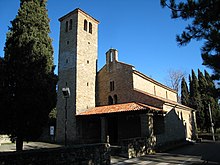Basilica of Santa Maria Assunta, Muggia
 From Wikipedia - Reading time: 3 min
From Wikipedia - Reading time: 3 min
| Basilica of Santa Maria Assunta Basilica di Santa Maria Assunta (in Italian) | |
|---|---|
 The basilica in 2008 | |
| Religion | |
| Affiliation | Roman Catholic |
| District | Diocese of Trieste |
| Rite | Roman |
| Ecclesiastical or organizational status | Basilica |
| Location | |
| Location | Muggia Vecchia, Italy |
| Geographic coordinates | 45°36′00″N 13°45′09″E / 45.6000°N 13.7526°E |
| Architecture | |
| Type | Church |
| Style | Romanesque, Gothic |
| Groundbreaking | 11th century |
| Completed | 13th century |
The Basilica of Santa Maria Assunta is the parish church of Muggia Vecchia, in Muggia, near Trieste, Italy.
In the past it was believed that the town of Muggia Vecchia had ceased to be inhabited after its destruction by the Genoese of Pagano Doria in 1353. Indeed, it was destroyed, leaving the basilica standing, by the Triestines, in constant struggle against the people of Muggia due to the salt pans.[1] It is thought that before the current church there existed a previous one, of which some parts of the structure have been preserved.
The current village of Muggia Vecchia is a place that arose relatively recently. It is currently the seat of the diocesan vocation center of the diocese of Trieste and has been run since 24 June 2014 by Don Andrea Destradi who is also parish priest of the parish of the Muggia Cathedral.
History
[edit]Before the destruction of the town, the parish of Muggia Vecchia was very important and was officiated by a chapter of canons. Some elements of the current church date back to the 11th century, the rest of the building was rebuilt in the 13th century, the same period as the bell tower. The building was restored between 1950 and 1951. The basilica of Muggia Vecchia became a parish church in 1982.[2]
Description
[edit]
The basilica, which measures 12.25 × 18.30 metres, has a "facciata a salienti" with a small bell gable.
The interior is divided into three naves. From the original structure remain the ambon, the lectern and two large and wide marble transennas or pluteus-shaped marble balustrades of Lombard art, datable to the Lombard period of King Liutprand (8th century) or in any case to the period of the Liutprandean Renaissance, 8th-9th century.[3][4][5] Inside the basilica there are frescoes from the 13th to 15th centuries.[6]
References
[edit]- ^ "Storia di Muggia Vecchia - La fase medievale del Parco di Muggia Vecchia, from the website ParcodiMuggiavecchia.it". Archived from the original on 2020-10-19. Retrieved 2023-01-22.
- ^ "Santa Maria Assunta".
- ^ La basilica di Santa Maria Assunta di Muggia Vecchia e gli antichi plutei longobardi
- ^ "Museo dell'Abbazia di San Colombano di Bobbio - La lapide di Cumiano, lastra identica ai plutei dell'antica chiesa di Muggia Vecchia". Archived from the original on 2021-03-23. Retrieved 2023-01-22.
- ^ "Storia e fasi costruttive della Basilica di Santa Maria Assunta, from the website ParcodiMuggiavecchia.it". Archived from the original on 2020-10-16. Retrieved 2023-01-22.
- ^ "Percorsi nelle chiese".
 KSF
KSF